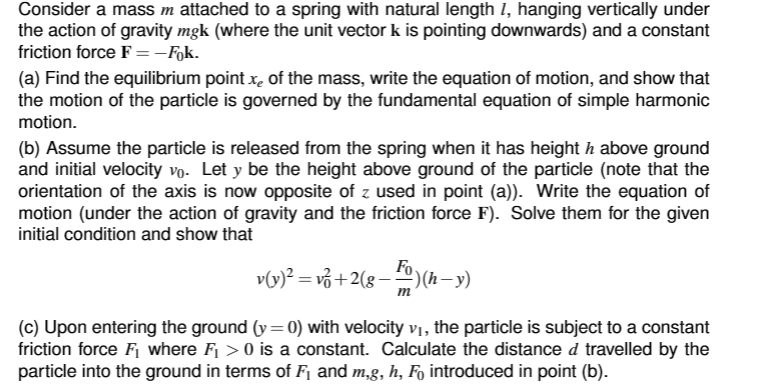Consider a mass m attached to a spring with natural length 7, hanging vertically under the action of gravity mgk (where the unit vector k is pointing downwards) and a constant friction force F = -Fok. (a) Find the equilibrium point of the mass, write the equation of motion, and show that the motion of the particle is governed by the fundamental equation of simple harmonic motion. (b) Assume the particle is released from the spring when it has height h above ground and initial velocity vo. Let y be the height above ground of the particle (note that the orientation of the axis is now opposite of z used in point (a)). Write the equation of motion (under the action of gravity and the friction force F). Solve them for the given initial condition and show that v() =vỏ +2(8 — , )(h – y) m (c) Upon entering the ground (y=0) with velocity v₁, the particle is subject to a constant friction force F₁ where F₁ >0 is a constant. Calculate the distance d travelled by the particle into the ground in terms of F₁ and m,g, h, Fo introduced in point (b).
Consider a mass m attached to a spring with natural length 7, hanging vertically under the action of gravity mgk (where the unit vector k is pointing downwards) and a constant friction force F = -Fok. (a) Find the equilibrium point of the mass, write the equation of motion, and show that the motion of the particle is governed by the fundamental equation of simple harmonic motion. (b) Assume the particle is released from the spring when it has height h above ground and initial velocity vo. Let y be the height above ground of the particle (note that the orientation of the axis is now opposite of z used in point (a)). Write the equation of motion (under the action of gravity and the friction force F). Solve them for the given initial condition and show that v() =vỏ +2(8 — , )(h – y) m (c) Upon entering the ground (y=0) with velocity v₁, the particle is subject to a constant friction force F₁ where F₁ >0 is a constant. Calculate the distance d travelled by the particle into the ground in terms of F₁ and m,g, h, Fo introduced in point (b).
Related questions
Question

Transcribed Image Text:Consider a mass m attached to a spring with natural length 7, hanging vertically under
the action of gravity mgk (where the unit vector k is pointing downwards) and a constant
friction force F =-Fok.
(a) Find the equilibrium point of the mass, write the equation of motion, and show that
the motion of the particle is governed by the fundamental equation of simple harmonic
motion.
(b) Assume the particle is released from the spring when it has heighth above ground
and initial velocity vo. Let y be the height above ground of the particle (note that the
orientation of the axis is now opposite of z used in point (a)). Write the equation of
motion (under the action of gravity and the friction force F). Solve them for the given
initial condition and show that
v(y)² = vz+2(g− ¹)(h—−y)
m
(c) Upon entering the ground (y=0) with velocity v₁, the particle is subject to a constant
friction force F₁ where F₁ >0 is a constant. Calculate the distance d travelled by the
particle into the ground in terms of F₁ and m,g, h, Få introduced in point (b).
Expert Solution
This question has been solved!
Explore an expertly crafted, step-by-step solution for a thorough understanding of key concepts.
Step by step
Solved in 5 steps with 4 images
